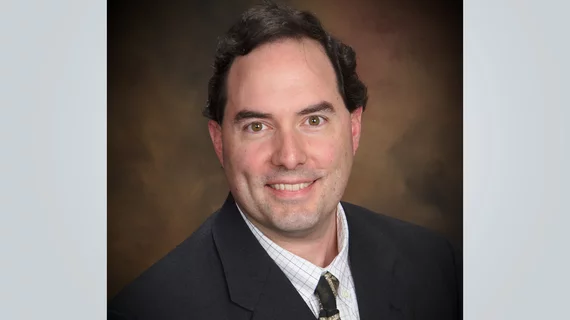Goodbye Private-Practice Headaches, Hello High-Tech Teleradiology
As far back as my undergraduate years, I knew I wanted to work in a field that combined medicine with computer science. I actually had a professor who told me that was a silly combination. He said there’d never be a real-world need for it. How wrong he was—and how fortunate I am to now work for a radiology practice whose hallmark is its enthusiastic embrace of IT and imaging informatics.
In fact, there’s a lot to like about practicing radiology with vRad. Like my colleague Jonathan Lee, MD, who gave his vRad testimonial last month, I too have found the pay excellent, the work-life balance just right and the opportunities to shine—clinically as well as collaboratively—plentiful.
But it’s vRad’s deft incorporation of technology to make me a better radiologist while freeing me to be a better husband and father that has emerged as a standout benefit for me.
I came to vRad five years ago after working for years as director of a smallish private practice and imaging center in Northeastern Pennsylvania. The very first thing I noticed was that the headaches, literal and figurative, that I’d been putting up with as a director—office politics, administrative minutiae, noninterpretative distractions—simply went away.
Meanwhile, the time I spend with eyes on images has skyrocketed. And a large part of the credit for that goes to vRad’s tech-savvy IT and operations-center (OC) staff.
Superior Support
Here’s an example of the OC in action. When I’m reading a case and need to talk to the treating provider about a critical finding, all I do is click a critical-finding call button right in the PACS. The OC support team immediately reaches out to the doctor and connects us as soon as the doctor picks up. I continue reading, either on that same study or the next one on my worklist, until the connection is made.
This greatly increases efficiency well beyond what a lot of radiologists have to deal with every day to get in touch with the responsible provider over critical findings.
The OC also makes the connection for me when I must report suspected abuse, regardless of what state the patient is in.
The same goes for technology support. If I’m having an issue with my system, there’s an IT support team on call 24/7. We use Skype for Business to instant-message (IM) back and forth with IT staff. You might IM them, “I’m having an issue with my mouse.” They log into your system remotely, see what the issue is and fix it—fast.
Nearly every issue I’ve ever run into during my time at vRad has been resolvable remotely by our IT team. The one time they couldn’t complete a repair remotely was when my monitor started acting up. That wasn’t a problem for long. vRad sent me a new monitor overnight.
Another thing that stands out for me about vRad’s tech-forward way is how our radiologists can readily consult with other radiologists.
When you’re in a small private practice, you’re pretty much on your own a lot of the time. At vRad, you have hundreds of radiologists to call on, and every one of them has a unique background and range of experience. You’re all subdivided within Skype by subspecialty. If I’m looking at a problem with a patient’s heart, for example, I can just click to get a consult with someone on the team who’s deeply experienced in cardiac radiology.
The upshot is that you’re getting the expertise of nearly 500 radiologists, many if not most of whom are experts in various subspecialties of radiology. That can be a lifeline—for you, for your treating physician colleague and, most of all, for the patient. It’s incredibly comforting to have that network of expertise so close at hand and so ready to help at the click of a button in your PACS.
Reading Done Right
Drilling down into ways vRad incorporates advanced technology to help its rads do their best work, I would be remiss if I failed to mention the elegance of our reading platform. It uses AI algorithms to organize and prioritize studies on your worklist according to nearly 20 criteria. These include things you would expect, such as state licensure, clinical privileges, and sub-specialization; and things you wouldn’t, such as reading preferences, how long it’s been since you read your last study—and even since you last moved your mouse.
The system also triages cases, putting highly urgent studies, such as those for stroke patients, at the top of the worklist.
The best part is how intelligently this system manages the unique worklists for so many radiologists. You never feel overly pressured, as vRad staffs at least two rads for every hour at every facility we serve, and often much more than that. The platform prevents rads from cherry-picking what they expect will be easy cases or cases not requiring additional communication with the local physician, for example, and you know the study at the top of your list is the most appropriate one for you at any given moment.
There are fail-safes for contingencies built in, too. Every so often a power outage, a co-worker’s illness or some other rare event puts you in the position of being the only available radiologist the system can find to read a given study. Here the system allows you to skip down through your list to open that case.
Finally, on this score, vRad’s customers working in ERs greatly appreciate the ability of our AI-powered worklist solution to package trauma studies together so the same radiologist can read them in succession. This helps the ER improve its patient throughput and thus save or improve lives. I derive considerable job satisfaction from this aspect alone.
My Computer, My Assistant
And then there’s dictation. Just about every radiologist uses voice-recognition software. vRad is not unique in that. However, we have an additional program on top of voice rec. It lets you focus on dictating findings‒in any sequence you want. It will take your dictated findings and plug them into report templates in the correct order, automatically including negative statements for organ areas you didn’t mention (because there were no findings present.) Just like that, the radiology report is automatically structured for review by the ordering clinician, in an assembled format that vRad configures to meet the client facility’s requirements.
Because your dictations are more efficient, you can spend more time reviewing images and describing findings—and less time attending to “the look” of the report.
Other practices may use a voice-rec and structured reporting system similar to vRad’s, but I have yet to hear of one that matches ours on rad-centric smarts. It’s like having a personal transcriptionist who helps you deliver the results the way the ordering clinician wants.
There’s one more tech-enabled feature I can’t work without—one-click communications with technologists to optimize image quality. This is especially important when we’re onboarding new hospital customers, but, as with ordering providers, it’s always available through vRad’s OC support system. It’s useful when, say, an image transfer goes buggy. Our support team steps in, makes the connection and makes sure the full image sets reach our radiologists—again, with little to no interruption to eyes on images.
All this and the comforts of working from home, too—or even while living in a vacation home, as I do with my family each summer. It’s enough to have me asking myself, sometimes several times a day: What took me so long to join vRad?
If only that doubting college professor could see me now.
Editor’s note: At RSNA 2018, vRad Chief Medical Officer Benjamin W. Strong, MD, will demonstrate the company’s singular approach to voice recognition, workflow segment integration and the use of AI/natural language processing in report creation. Demos begin at Booth #7938 (North Hall) Monday at 11 a.m. and 3 p.m., Tuesday at 11 a.m. and 3 p.m., and Wednesday at 11 a.m. and 4 p.m. https://www.vrad.com/rsna

